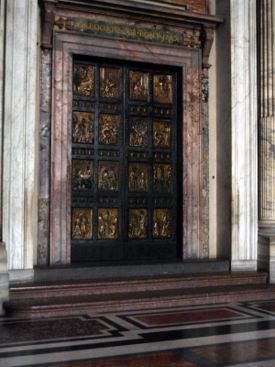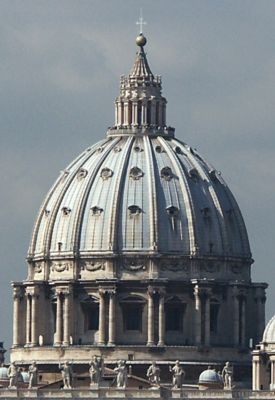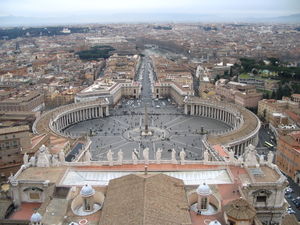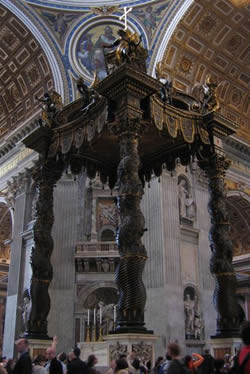

 |
|||||||||||
 |
|||||||||||
“St. Peter’s, the most magnificent church in Christendom and the fruit of many talents, soars triumphantly above the Vatican Hill”. - John Julius Norwich, ed. |
|
 |
Entrances The entrances throughout St. Peter’s have inscriptions above them. One example is above the main entrance; it is in honor of the prince of apostles. The Façade has statues and clocks on either side. Between the Façade and the interior is the Portico. It also contains statues and sculptures. The south door of the church is the “Door of the Dead”, and the north door is the “Holy Door”. The “Holy Door” is only opened for celebrations. |
Dome The brick dome of St. Peter’s is very large. It is 138ft in diameter and rises 452ft above the street (390ft above floor). There are four iron chains to compose and compressed ring, and four internal piers each 60sq.ft. The dome buttressed by the apses and supposed internally by these four massive piers. Michelangelo started the design but died just as the base was completed, so architect Giacomo della Porta took over. He developed an egg shape dome, unlike the previous planned sphereical shape. Many changes took place as the design evolved.
The Lantern- St. Peter’s also has a “lantern” designed by Fontana. The dome rises to a two-stage lantern and is capped with a spire. |
 |
 |
St. Peter’s Square St. Peter’s Square is east of the church; the great architect Bernini built it. It is surrounded by elliptical colonnade with two pairs of Doric columns. This part of the church is referred to as “the motherly arms of the church”. It is a great example of Baroque Architecture. It contains two fountains, an obelisk (originally from Egypt, second largest ever) and used to have a bronze globe (removed). |
Interior Inside of St. Peter’s is the home of many rooms, monuments and memorials. Some of them include: Michelangelo’s Pieta, Queen Christina of Sweden, the Altar of St. Sebastian, the Chapel of the Blessed Sacrament, two kneeling angels, statues of Pope Gregory XIII and Gregory XIV, and 39 other statues of Saints. On the right side there are three main altars (St. Wenceslas, St. Processus and St. Martinian, and St. Erasmus), and there are also three on the left side (St. Peter’s Crucifixion, St. Joseph, and St. Thomas). The inside also contains many passageways to the many tombs. |
 |